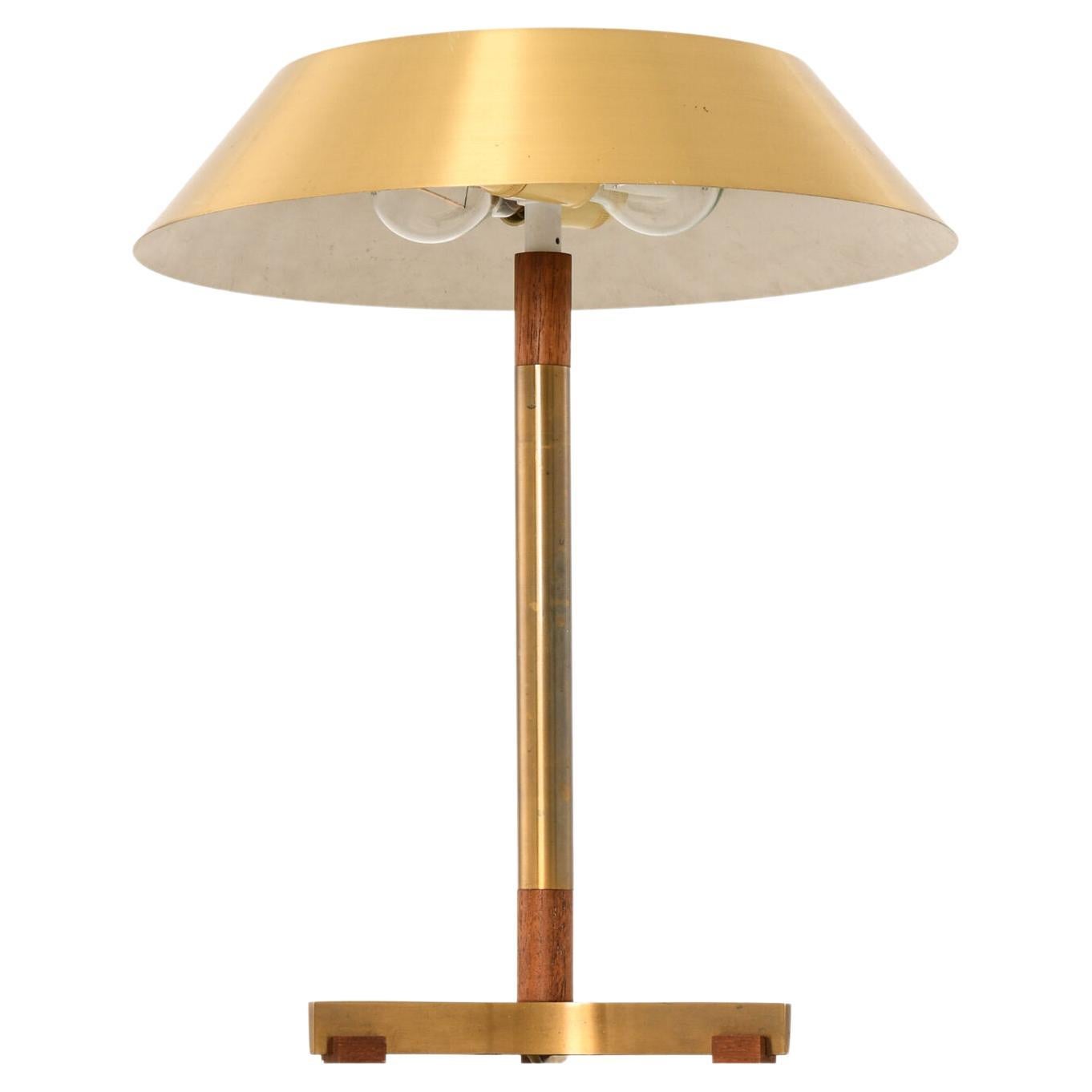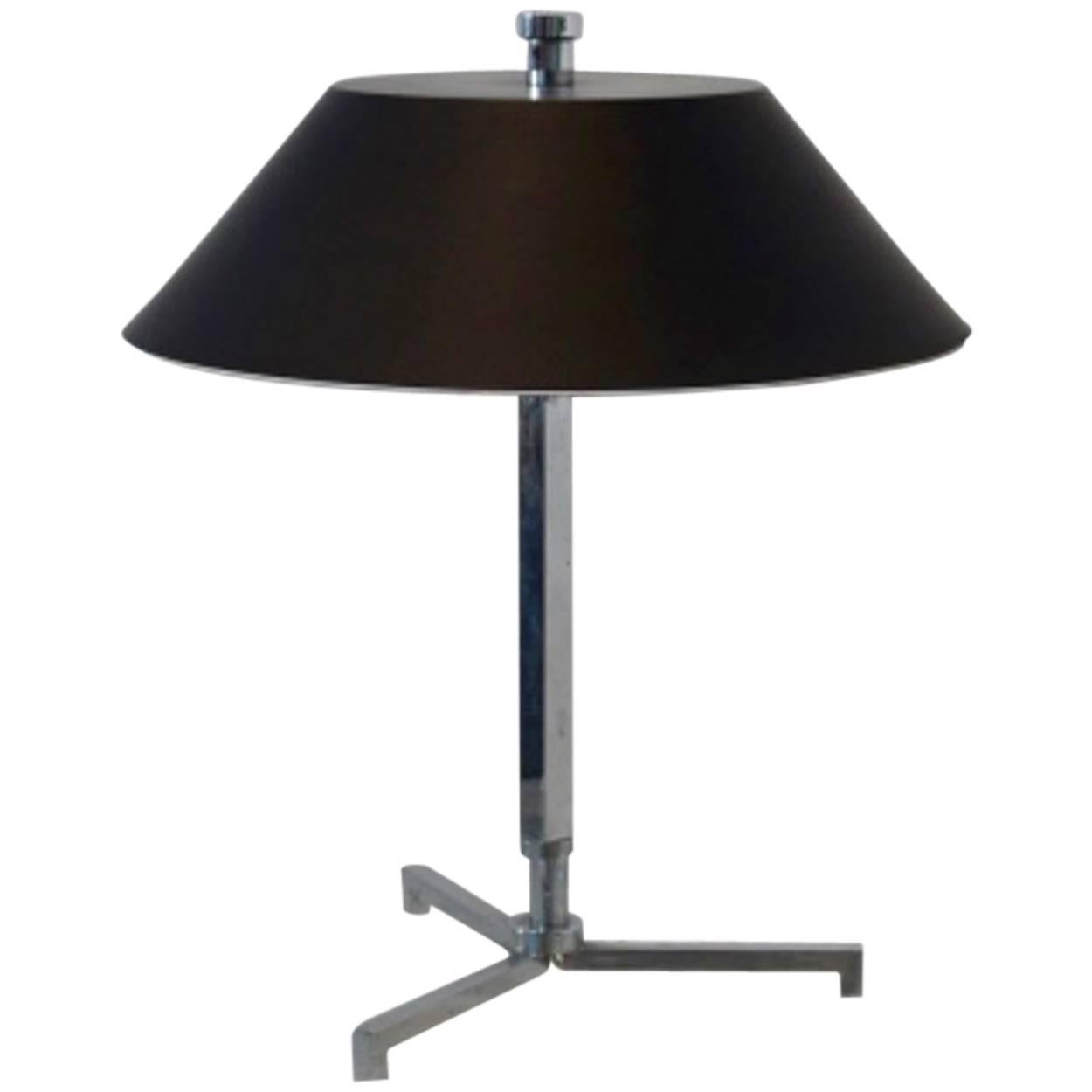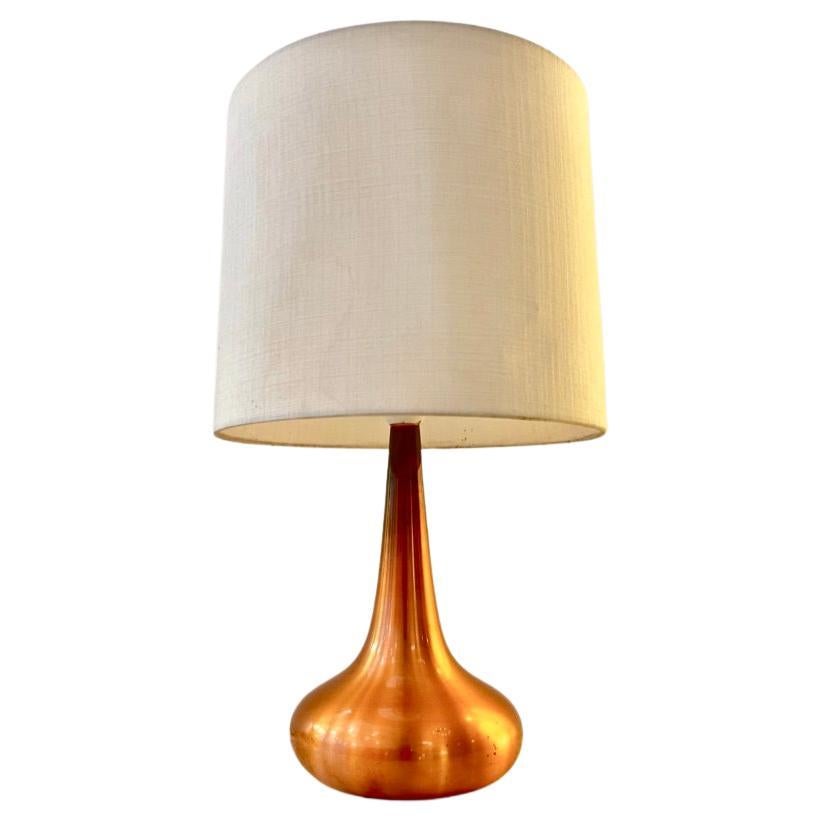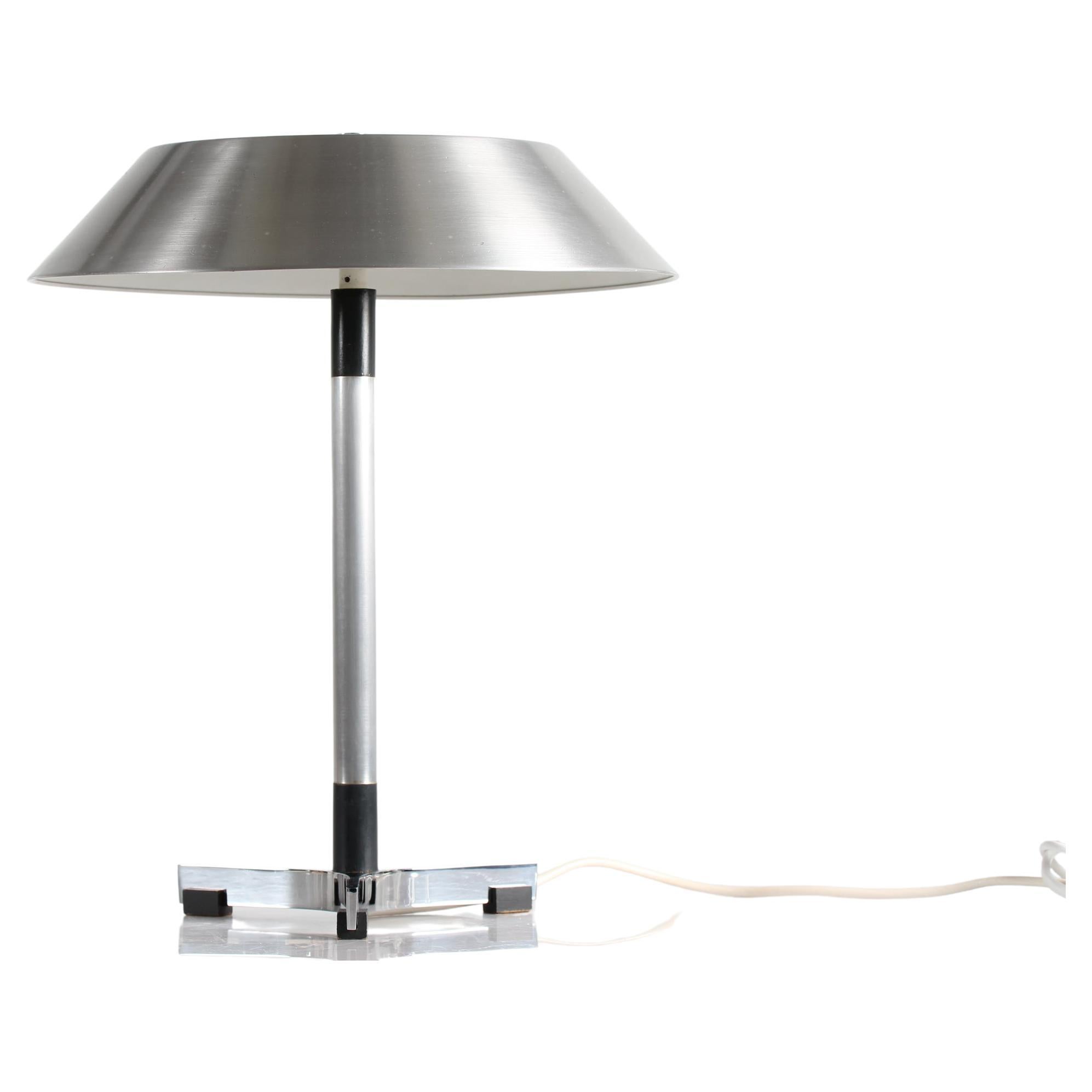Jo Hammerborg Table Lamp Model Senior Produced by Fog & Mørup in Denmark
About the Item
- Creator:Jo Hammerborg (Designer),Fog & Mørup (Manufacturer)
- Dimensions:Height: 18.12 in (46 cm)Width: 13.39 in (34 cm)Depth: 13.39 in (34 cm)
- Power Source:Plug-in
- Voltage:220-240v
- Style:Scandinavian Modern (Of the Period)
- Materials and Techniques:
- Place of Origin:
- Period:
- Date of Manufacture:1960s
- Condition:Wear consistent with age and use.
- Seller Location:WIJCKEL, NL
- Reference Number:1stDibs: LU8306233406232
Jo Hammerborg
Johannes (Jo) Hammerborg was a passionate innovator and lighting designer credited with the success of the Danish lighting company Fog & Mørup. His sleek ceiling lights, floor lamps and table lamps are characterized by the simple lines and clean aesthetic of Scandinavian modern design.
Hammerborg was born in Randers, Denmark, in 1920. As a young man, he trained as a silversmith before attending the Royal Danish Academy of Fine Arts. In 1949, Hammerborg began working as a silversmith at leading Danish silverware brand Georg Jensen. He worked at Georg Jensen until 1957, when he became the chief designer at Fog & Mørup.
Hammerborg brought both his modernist designs and his good business sense to Fog & Mørup. He helped the company create a strong brand and implemented a stringent manufacturing process to ensure high quality. During his time with Fog & Mørup, Hammerborg designed over 60 lighting fixtures and collaborated with other designers such as Torsten Thorup and Claus Bonderup, Erik Balslev, Sophus Frandsen and more. Vintage Hammerborg lighting is functional and accessible and was intended for easy coordination with modern interior decor.
Among Hammerborg's most famous works are his 1966 Trombone series. Trombone pendants, floor lamps and table lamps feature cylindrical shades in various metallic finishes and are fantastically versatile. The Milieu pendant from 1975 is another notable Hammerborg design. Its hemispherical shape gives the shade a light and airy quality, and Hammerborg's love of parachuting inspired its distinctive appearance.
Hammerborg left Fog & Mørup in 1980. The company subsequently underwent a series of mergers that eventually led to its closure.
Hammerborg’s brilliant lighting creations remain in high demand today. The Hammerborg family has collaborated with Danish furniture brand Warm Nordic — which has reissued iconic mid-century works such as Hans Olsen’s inviting Fried Egg armchair — in order to relaunch the Trombone and Milieu series.
On 1stDibs, find an extensive collection of vintage Jo Hammerborg lighting.
Fog & Mørup
Fog & Mørup was a legendary Danish lighting manufacturer best known to collectors for the sleek and sculptural ceiling lights, wall lights and floor lamps that the company produced in the postwar years. Its vintage fixtures are ideal for design enthusiasts looking to introduce a splash of Scandinavian modernist ingenuity into a space.
Founders Ansgar Fog and Erik Mørup reportedly met in Aarhus, Denmark, in 1902. They became fast friends and discussed going into business together. An opportunity materialized a couple of years later when they discovered a newspaper advertisement — an Aarhus consignment warehouse had been vacated and its landowner was looking for a business to sign a new lease. The friends took a chance and established a wholesale metalwork business.
In 1906, Fog and Mørup moved the business to Copenhagen and focused on lighting. They purchased an electrical company in 1913 and opened a lighting factory shortly thereafter. The following two decades saw rapid expansion. One of the most notable Fog & Mørup designs from the interwar period was the brass Kongelys table lamp, created by Niels Rasmussen Thykier.
Johannes (Jo) Hammerborg, an alum of leading Danish silverware brand Georg Jensen, joined Fog & Mørup as head of design in the late 1950s, ushering in a period of commercial success and international prominence.
Hammerborg was an innovative designer whose sleek and streamlined aesthetic came to define the company. During his time with Fog & Mørup, Hammerborg designed over 60 lighting fixtures and collaborated with other designers such as Erik Balslev, Sophus Frandsen and more. Fog & Mørup also worked with designers Torsten Thorup and Claus Bonderup, who created the iconic trumpet-shaped Semi pendant light in 1967.
Fog & Mørup sales remained healthy into the 1970s. A merger followed in the ensuing decades and the brand definitively closed in 2005 after being acquired by Nordlux.
Find vintage Fog & Mørup lighting on 1stDibs.
- ShippingRetrieving quote...Ships From: WIJCKEL, Netherlands
- Return PolicyA return for this item may be initiated within 3 days of delivery.
- Kaare Klint Sofa Model 5011 in Original Cognac Leather Rud Rasmussen, DenmarkBy Rud Rasmussen, Kaare KlintLocated in WIJCKEL, NLTwo-seater sofa model 5011 in original cognac leather and six-legged mahogany base. Produced by Rud. Rasmussen Cabinetmakers, Denmark. Minor marks on the frame, patina to the leather. Back covered in original canvas. Shown at the Copenhagen Cabinetmakers’ Guild exhibition in 1935. Signed with decal manufacturer’s label to underside: (Rud. Rasmussens Snedkerier). Kaare Klint is widely recognized as the father of Danish modern design. It is hard to overstate his influence. He developed an entirely new analytical approach to furniture design that his students at the Danish Academy of Art would emulate for years to come, yet was also inspired by historic designs from various cultures, modernizing and re-interpreting classic pieces for new generations. Literature: Gorm Harkær, Klintiana: “Kaare Klint”, vol.2, pg 94. Kaare Klint (1888-1954) is regarded as the founding father of Danish Modernim. As an architect, furniture designer and leading professor at the Department of Furniture Design at the Royal Danish Academy of Fine Arts, Copenhagen, Klint established the principles of modern Danish furniture by combining a profound appreciation of traditional construction techniques with a modernist emphasis on function and a rejection of ornaments. Klint’s design was always based on relentless research; he never compromised. Every piece had to fulfill its purpose, be completely clear in its construction with dimensions and proportions corresponding to the human body and display materials and craftsmanship of the highest quality. Logic, often using a mathematical system of measures, and a constructive way of thinking were the foundation of Klint’s philosophy of furniture design. Like many of his contemporaries, counting Le Corbusier and Walter Gropius, he advocated standardization and functional requirements and dismissed the use of all ornamentation. But Klint realized his vision in wood and leather, using traditional craftsmen and working methods and often finding inspiration in historical models. In this way, he charted the course for an alternative Nordic Functionalism that idealized the workshop and the collaboration between furniture architects and cabinetmakers as opposed to the factory. Kaare Klint’s first major work was a collaboration with his mentor, the architect Carl Petersen. In 1914 they were commissioned to design furniture and fixtures for Faaborg Art Museum. One of the highlights to emerge from this commission was the Faaborg chair, a light and elegant chair with clear references to classical furniture. The construction and proportions of an 18th century English Chippendale chair...Category
Vintage 1940s Danish Scandinavian Modern Sofas
MaterialsLeather, Mahogany
- Kaare Klint Armchair Model 3758a in Leather and Mahogany Rud Rasmussen DenmarkBy Rud Rasmussen, Kaare KlintLocated in WIJCKEL, NLArmchair model 3758 A in original red indian leather and mahogany base. Model designed in 1927 for the Danish Museum of Decorative Art, produced by Rud Rasmussen in the 1940’s. Signed with manufacturer’s label to underside: (Rud. Rasmussens Snedkerier). Kaare Klint is widely recognized as the father of Danish modern design. It is hard to overstate his influence. He developed an entirely new analytical approach to furniture design that his students at the Danish Academy of Art would emulate for years to come, yet was also inspired by historic designs from various cultures, modernizing and re-interpreting classic pieces for new generations. Literature: Kaare Klint, Harkær, pg. 28-30. Dansk Møbelkunst Gennem 40 Aar: 1927-1936, Jalk, pg. 169. Danish Chairs, Oda, pg. 22-23. Kaare Klint (1888-1954) is regarded as the founding father of Danish Modernim. As an architect, furniture designer and leading professor at the Department of Furniture Design at the Royal Danish Academy of Fine Arts, Copenhagen, Klint established the principles of modern Danish furniture by combining a profound appreciation of traditional construction techniques with a modernist emphasis on function and a rejection of ornaments. Klint’s design was always based on relentless research; he never compromised. Every piece had to fulfill its purpose, be completely clear in its construction with dimensions and proportions corresponding to the human body and display materials and craftsmanship of the highest quality. Logic, often using a mathematical system of measures, and a constructive way of thinking were the foundation of Klint’s philosophy of furniture design. Like many of his contemporaries, counting Le Corbusier and Walter Gropius, he advocated standardization and functional requirements and dismissed the use of all ornamentation. But Klint realized his vision in wood and leather, using traditional craftsmen and working methods and often finding inspiration in historical models. In this way, he charted the course for an alternative Nordic Functionalism that idealized the workshop and the collaboration between furniture architects and cabinetmakers as opposed to the factory. Kaare Klint’s first major work was a collaboration with his mentor, the architect Carl Petersen. In 1914 they were commissioned to design furniture and fixtures for Faaborg Art Museum. One of the highlights to emerge from this commission was the Faaborg chair, a light and elegant chair with clear references to classical furniture. The construction and proportions of an 18th century English Chippendale...Category
Vintage 1950s Danish Scandinavian Modern Armchairs
MaterialsLeather, Mahogany
- Fritz Hansen Furniture poster for Arne Jacobsen models butterfly chair DanishBy Fritz Hansen, Arne JacobsenLocated in WIJCKEL, NLHere is a very rare and desirable Furniture poster by the Danish designer Arne Jacobsen for Fritz Hansen representing the serie 7 chair or butterfly chair in a variety of different c...Category
20th Century Danish Scandinavian Modern Posters
MaterialsPaper
- Kaare Klint Sofa Model 5011 Original Cognac Leather for Rud Rasmussen DenmarkBy Rud Rasmussen, Kaare KlintLocated in WIJCKEL, NLThree-seater sofa model 5011 in original leather and eight-legged ash base. Produced by Rud. Rasmussen Cabinetmakers, Denmark. Minor marks on the frame, patina to the leather. Shown at the Copenhagen Cabinetmakers’ Guild exhibition in 1935. Kaare Klint is widely recognized as the father of Danish modern design. It is hard to overstate his influence. He developed an entirely new analytical approach to furniture design that his students at the Danish Academy of Art would emulate for years to come, yet was also inspired by historic designs from various cultures, modernizing and re-interpreting classic pieces for new generations. Literature: Gorm Harkær, Klintiana: “Kaare Klint”, vol.2, pg 94. Kaare Klint (1888-1954) is regarded as the founding father of Danish Modernim. As an architect, furniture designer and leading professor at the Department of Furniture Design at the Royal Danish Academy of Fine Arts, Copenhagen, Klint established the principles of modern Danish furniture by combining a profound appreciation of traditional construction techniques with a modernist emphasis on function and a rejection of ornaments. Klint’s design was always based on relentless research; he never compromised. Every piece had to fulfill its purpose, be completely clear in its construction with dimensions and proportions corresponding to the human body and display materials and craftsmanship of the highest quality. Logic, often using a mathematical system of measures, and a constructive way of thinking were the foundation of Klint’s philosophy of furniture design. Like many of his contemporaries, counting Le Corbusier and Walter Gropius, he advocated standardization and functional requirements and dismissed the use of all ornamentation. But Klint realized his vision in wood and leather, using traditional craftsmen and working methods and often finding inspiration in historical models. In this way, he charted the course for an alternative Nordic Functionalism that idealized the workshop and the collaboration between furniture architects and cabinetmakers as opposed to the factory. Kaare Klint’s first major work was a collaboration with his mentor, the architect Carl Petersen. In 1914 they were commissioned to design furniture and fixtures for Faaborg Art Museum. One of the highlights to emerge from this commission was the Faaborg chair, a light and elegant chair with clear references to classical furniture. The construction and proportions of an 18th century English Chippendale...Category
Vintage 1970s Danish Scandinavian Modern Sofas
MaterialsLeather, Ash
- Borge Mogensen Drop-Leaf Dining Table in Teak for Soborg Mobelfabrik, DenmarkBy Børge MogensenLocated in WIJCKEL, NLDanish Modernism free-standing office desk or dining table by Borge Morgensen, made of fined teak top and beech frame, fitted with drop-leaves on ...Category
Vintage 1950s Danish Scandinavian Modern Dining Room Tables
MaterialsBeech, Teak
- Poul Kjaerholm PK 53 Work Table-Desk in Ash for E. Kold Christensen, DenmarkBy E. Kold Christensen, Poul KjærholmLocated in WIJCKEL, NLDanish design work table or desk from 1957 by Poul Kjærholm for E. Kold Christensen. Matte chromed flattened steel frame, ash pine table-top. Frame marked with stamp manufacturer. ...Category
Vintage 1950s Danish Scandinavian Modern Dining Room Tables
MaterialsSteel
- Jo Hammerborg Table Lamp Model President Produced by Fog & MørupBy Jo HammerborgLocated in Limhamn, Skåne länRare table lamp model President designed by Jo Hammerborg. Produced by Fog & Mørup in Denmark.Category
Vintage 1950s Danish Scandinavian Modern Table Lamps
MaterialsBrass
- Chrome President Light by Jo Hammerborg for Fog & MørupBy Jo Hammerborg, Fog & MørupLocated in Voorburg, NLThis Mid-Century desk light, model 'President', was designed by Jo Hammerborg in the 1960s and later manufactured by Fog & Morup in Denmark. It has a chrome frame and a metal black s...Category
Mid-20th Century Danish Mid-Century Modern Table Lamps
MaterialsChrome, Steel
- Vintage Copper Table Lamp by Jo Hammerborg produced by Fog&Morup, Denmark 1960sBy Jo Hammerborg, Fog & MørupLocated in Geneva, CHBeautiful little copper "Orient" table lamp by Jo Hammerborg produced by Fog&Mørup, Denmark ca. 1950's Original shade and electrification, fully funcional on/off switch. Signed at t...Category
Vintage 1950s Danish Table Lamps
MaterialsCopper
- Table Lamp Model "Presidente" by Jo Hammerborg for Fog & MørupBy Jo Hammerborg, Fog & MørupLocated in Lisboa, LisboaMid-century table lamp model "President" by Jo Hammerborg for Fog & Mørup. Made in Denmark. This table lamp features two light sources and is made of aluminium with tripod foot stem ...Category
Vintage 1960s Danish Mid-Century Modern Table Lamps
MaterialsMetal, Aluminum
- Jo Hammerborg President Vintage Desk Lamp of Aluminium by Fog & Mørup, 1960sBy Jo Hammerborg, Fog & MørupLocated in Aarhus C, DKDanish vintage table- and desk lamp model President designed by Jo Hammerborg in the 1960s. This one is made of aluminium with brushed steel look...Category
Vintage 1960s Danish Mid-Century Modern Table Lamps
MaterialsAluminum, Metal
- Deadstock President Lamp Jo Hammerborg Fog & Morup, DenmarkBy Jo Hammerborg, Fog and Morup, Fog & MørupLocated in Mortsel, BEPresenting the epitome of Danish design from the 1960s, the 'President' lamp designed by Jo Hammerborg for Fog & Mørup is a true gem that exudes timeless elegance. Crafted with metic...Category
Vintage 1960s Danish Mid-Century Modern Table Lamps
MaterialsBrass







